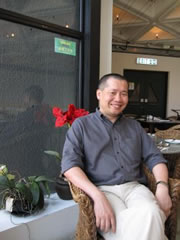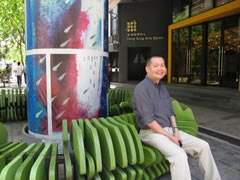Chartering a new course for WKCD: Louis Yu
 Louis Yu, a Hong Kong born and bred arts administrator, has moved a step forward with his recent appointment as the Performing Arts Policy and Management Services Executive Director of the West Kowloon Cultural District Authority (the Authority). Prior to this role, Louis spent 10 years as the Executive Director of the Hong Kong Arts Centre and Chief Executive of the Hong Kong Arts Development Council (ADC). He attributes his successful career to a stroke of luck that saw his initial involvement in the industry as an art critic, before gaining extensive experience as an administrator and subsequently taking planning responsibility for the WKCD project as a policy decision-maker. He is fully aware of the challenge ahead and the heavy responsibility and commitment he is expected to shoulder in his new position. But to do himself justice, he is determined to stay the course and move ahead with caution, until his efforts have borne fruit. Louis Yu, a Hong Kong born and bred arts administrator, has moved a step forward with his recent appointment as the Performing Arts Policy and Management Services Executive Director of the West Kowloon Cultural District Authority (the Authority). Prior to this role, Louis spent 10 years as the Executive Director of the Hong Kong Arts Centre and Chief Executive of the Hong Kong Arts Development Council (ADC). He attributes his successful career to a stroke of luck that saw his initial involvement in the industry as an art critic, before gaining extensive experience as an administrator and subsequently taking planning responsibility for the WKCD project as a policy decision-maker. He is fully aware of the challenge ahead and the heavy responsibility and commitment he is expected to shoulder in his new position. But to do himself justice, he is determined to stay the course and move ahead with caution, until his efforts have borne fruit.
On a sunny morning, the new Executive Director enthused over his vision for the WKCD, confident in his assertion that the project will become a new standard-bearer for arts development. The project will take a multi-faceted approach to the arts, drawing upon the diverse experiences of the administrative team to deliver the concept of interactive and participative learning. WKCD will be the perfect venue for the cultivation of local artistic talent, which will in turn support the healthy growth of Hong Kong’s cultural sector.
How will the administrative experience you gained from your involvement in the ADC help your work on the WKCD?
Undoubtedly my three years with the ADC has helped to build my self-confidence and the experience has taught me how to make the most of public-sector resources. I was also fortunate to gain vital exposure to all the aspects of the arts, be it amateur or professional, alternative or even community arts. As an administrator these are key experiences that I bring to the role. My work has enabled me to keep abreast of industry trends from different art domains, providing me with a good grounding especially in resource allocation. The WKCD represents the largest single undertaking by the HKSAR Government in terms of resource investment in arts and culture. My experience with the ADC has equipped me with the tools to deal with the needs of different stakeholder groups and manage the expectations of the general public about the use of public funds.
Do you have a tentative idea about the way forward for the WKCD’s performing arts activities?
I believe a new course should be chartered for the WKCD. Our traditional idea of art used to be one of passive enjoyment, but there has been a growing emphasis in recent years on audience participation. The public are no longer happy with just buying a ticket and going to a show, they are far more seasoned and look for opportunities to learn through participation. I would think twice about using the term “education” as it suggests a single-track approach. I prefer the term “learning and participation”, because it describes more aptly the diverse and interactive learning and participative experiences of an audience. In fact, this is already an established trend as more and more performance venues are emerging as places where audiences can participate and learn. We have yet to determine the detailed positioning of the WKCD’s performing arts venues, but personally I would like to see the WKCD emerging as a destination that combines art appreciation with learning and participation, rather than just a place for art consumption.
 In response to this dominant trend, how would you develop the necessary hardware and software in such a way that we can better meet the need for cultivating the younger generation? In response to this dominant trend, how would you develop the necessary hardware and software in such a way that we can better meet the need for cultivating the younger generation?
In terms of planning, we can reserve more space in our facilities for learning and participation. At this moment, such amenities are simply inadequate. Regarding software development, we need to organise more activities, such as workshops and awareness programmes before and after each show. In this way, performing arts will take on greater meaning than just a simple act of consumption. This may not be a new concept, but I believe that the WKCD will provide an opportunity to put these ideas to work. |

